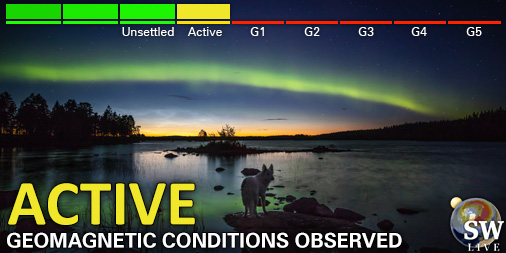Tabela charakterystyk regionów plam słonecznych według systemu Zürich/McIntosh
The magnetic classification of sunspots based on the Zürich/McIntosh system: Classification Values (C.V.) derived by Malde is: "A sunspot count derived using weighting of Zürich (Modified) McIntosh classifications“. The C.V. count intends to measure the variety of sunspot region classification with respect to their ability of survival, typical life style, complexity, structure, polarity, size and elongation on the solar disk.
The sunspots on the earth-facing side of the Sun are counted every day by the space weather specialists and they give each sunspot region a magnetic classification and a spot classification. On our website you'll find an overview of all the sunspot groups together with their classification. Below you get to know what these mean.

| CV-nbr. | ZMcI-type | Typ magnetyczny | Długość | Penumbra type | Distribution |
|---|---|---|---|---|---|
| 1 | Axx | Jednobiegunowy | - | Brak penumbry | Pojedynczy |
| 2 | Bxo | Bipolar | - | Brak penumbry | Otwarte |
| 3 | Bxi | Bipolar | - | Brak penumbry | Intermediate |
| 4 | Hrx | Jednobiegunowy | - | Rudimentary | Pojedynczy |
| 5 | Cro | Bipolar one side | - | Rudimentary | Otwarte |
| 6 | Cri | Bipolar one side | - | Rudimentary | Intermediate |
| 7 | Hax | Jednobiegunowy | - | Asymetryczny, <2,5° | Pojedynczy |
| 8 | Cao | Bipolar one side | - | Asymetryczny, <2,5° | Otwarte |
| 9 | Cai | Bipolar one side | - | Asymetryczny, <2,5° | Intermediate |
| 10 | Hsx | Jednobiegunowy | - | Symmetric, <2,5° | Pojedynczy |
| 11 | Cso | Bipolar one side | - | Symmetric, <2,5° | Otwarte |
| 12 | Csi | Bipolar one side | - | Symmetric, <2,5° | Intermediate |
| 13 | Dro | Bipolar | <10° | Rudimentary | Otwarte |
| 14 | Ero | Bipolar | >10° <15° | Rudimentary | Otwarte |
| 15 | Fro | Bipolar | >15° | Rudimentary | Otwarte |
| 16 | Dri | Bipolar | <10° | Rudimentary | Intermediate |
| 17 | Eri | Bipolar | >10° <15° | Rudimentary | Intermediate |
| 18 | Fri | Bipolar | >15° | Rudimentary | Intermediate |
| 19 | Dao | Bipolar | <10° | Asymetryczny, <2,5° | Otwarte |
| 20 | Eao | Bipolar | >10° <15° | Asymetryczny, <2,5° | Otwarte |
| 21 | Fao | Bipolar | >15° | Asymetryczny, <2,5° | Otwarte |
| 22 | Dai | Bipolar | <10° | Asymetryczny, <2,5° | Intermediate |
| 23 | Eai | Bipolar | >10° <15° | Asymetryczny, <2,5° | Intermediate |
| 24 | Fai | Bipolar | >15° | Asymetryczny, <2,5° | Intermediate |
| 25 | Dso | Bipolar | <10° | Symmetric, <2,5° | Otwarte |
| 26 | Eso | Bipolar | >10° <15° | Symmetric, <2,5° | Otwarte |
| 27 | Fso | Bipolar | >15° | Symmetric, <2,5° | Otwarte |
| 28 | Dsi | Bipolar | <10° | Symmetric, <2,5° | Intermediate |
| 29 | Esi | Bipolar | >10° <15° | Symmetric, <2,5° | Intermediate |
| 30 | Fsi | Bipolar | >15° | Symmetric, <2,5° | Intermediate |
| 31 | Dac | Bipolar | <10° | Asymetryczny, <2,5° | Kompaktowy |
| 32 | Eac | Bipolar | >10° <15° | Asymetryczny, <2,5° | Kompaktowy |
| 33 | Fac | Bipolar | >15° | Asymetryczny, <2,5° | Kompaktowy |
| 34 | Dsc | Bipolar | <10° | Symmetric, <2,5° | Kompaktowy |
| 35 | Esc | Bipolar | >10° <15° | Symmetric, <2,5° | Kompaktowy |
| 36 | Fsc | Bipolar | >15° | Symmetric, <2,5° | Kompaktowy |
| 37 | Hkx | Jednobiegunowy | - | Asymetryczny, >2,5° | Pojedynczy |
| 38 | Cko | Bipolar one side | - | Asymetryczny, >2,5° | Otwarte |
| 39 | Cki | Bipolar one side | - | Asymetryczny, >2,5° | Intermediate |
| 40 | Hhx | Jednobiegunowy | - | Symmetric, >2,5° | Pojedynczy |
| 41 | Cho | Bipolar one side | - | Symmetric, >2,5° | Otwarte |
| 42 | Chi | Bipolar one side | - | Symmetric, >2,5° | Intermediate |
| 43 | Dko | Bipolar | <10° | Asymetryczny, >2,5° | Otwarte |
| 44 | Eko | Bipolar | >10° <15° | Asymetryczny, >2,5° | Otwarte |
| 45 | Fko | Bipolar | >15° | Asymetryczny, >2,5° | Otwarte |
| 46 | Dki | Bipolar | <10° | Asymetryczny, >2,5° | Intermediate |
| 47 | Eki | Bipolar | >10° <15° | Asymetryczny, >2,5° | Intermediate |
| 48 | Fki | Bipolar | >15° | Asymetryczny, >2,5° | Intermediate |
| 49 | Dho | Bipolar | <10° | Symmetric, >2,5° | Otwarte |
| 50 | Eho | Bipolar | >10° <15° | Symmetric, >2,5° | Otwarte |
| 51 | Fho | Bipolar | >15° | Symmetric, >2,5° | Otwarte |
| 52 | Dhi | Bipolar | <10° | Symmetric, >2,5° | Intermediate |
| 53 | Ehi | Bipolar | >10° <15° | Symmetric, >2,5° | Intermediate |
| 54 | Fhi | Bipolar | >15° | Symmetric, >2,5° | Intermediate |
| 55 | Dkc | Bipolar | <10° | Asymetryczny, >2,5° | Kompaktowy |
| 56 | Ekc | Bipolar | >10° <15° | Asymetryczny, >2,5° | Kompaktowy |
| 57 | Fkc | Bipolar | >15° | Asymetryczny, >2,5° | Kompaktowy |
| 58 | Dhc | Bipolar | <10° | Symmetric, >2,5° | Kompaktowy |
| 59 | Ehc | Bipolar | >10° <15° | Symmetric, >2,5° | Kompaktowy |
| 60 | Fhc | Bipolar | >15° | Symmetric, >2,5° | Kompaktowy |
Every Cv group/regions Cv-count are summarized per day and averaged per month.
Aktualne dane sugerują, że istnieje niewielkie prawdopodobieństwo pojawienia się zorzy polarnej w następujących regionach o wysokiej szerokości geograficznej w najbliższej przyszłości
Fairbanks, AKNajnowsze wiadomości
Najnowsze wiadomości z forum
Wesprzyj SpaceWeatherLive.com!
Wielu ludzi odwiedza SpaceWeatherLive aby śledzić aktywność słoneczną lub sprawdzić czy jest szansa na zaobserwowanie zorzy polarnej. Niestety, większy ruch na stronie oznacza większe koszty utrzymania serwera. Dlatego, jeśli jesteś zadowolony ze strony SpaceWeatherLive, zachęcamy do wspierania nas finansowo. Dzięki temu będziemy mogli utrzymać naszą stronę.

Alerty
04:15 UTC - Aktywność geomagnetyczna
Aktywne warunki geomagnetyczne (Kp4) Osiągnięty próg: 03:57 UTC
02:30 UTC - Indeks mocy półkuli
Model OVATION przewiduje, że index mocy półkuli osiągnie 50GW o 03:23 UTC
środa, 16 kwietnia 2025
21:45 UTC - Aktywność geomagnetyczna
Słaba burza geomagnetyczna G1 (Kp5) osiągnięty próg: 21:36 UTC
21:00 UTC - Aktywność geomagnetyczna
Bardzo silna burza geomagnetyczna G4 (Kp8) osiągnięty próg: 20:55 UTC
19:45 UTC - Aktywność geomagnetyczna
Silna burza geomagnetyczna G3 (Kp7) Osiągnięto próg: 19:25 UTC
Fakty na temat pogody kosmicznej
| Ostatnie rozbłyski klasy X | 2025/03/28 | X1.1 |
| Ostatnie rozbłyski klasy M | 2025/04/15 | M1.2 |
| Ostatnia burza geomagnetyczna | 2025/04/16 | Kp8- (G4) |
| Dni bez plam słonecznych | |
|---|---|
| Ostatni dzień bez skazy | 2022/06/08 |
| Średnia miesięczna liczba plam słonecznych | |
|---|---|
| marca 2025 | 134.2 -20.4 |
| kwietnia 2025 | 120.5 -13.7 |
| Ostatnie 30 dni | 118.3 -22.1 |






